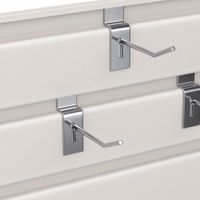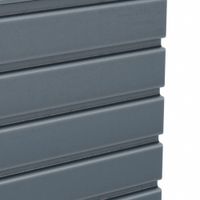Call +(254) 703 030 000 / 751 483 999 / 721 704 777
- Home
- Material Handling
- Storage Workspace
- Storage Panels Panel Racks
- Slatwall Panels Racks Accessories
.....Read More
Frequently Asked Questions
What are Slatwall panels used for?
Slatwall panels are versatile display and storage systems commonly used in retail environments, garages, and workshops. They consist of panels with horizontal grooves or slats that accommodate various accessories like hooks, shelves, and baskets. This adaptability allows for efficient organization and display of merchandise or tools.
In retail settings, Slatwall panels are used to maximize wall space and create flexible displays. They allow retailers to easily rearrange products, highlight promotions, and optimize the layout to enhance customer experience. The panels can hold a wide range of items, from clothing and accessories to electronics and sporting goods, making them ideal for diverse retail needs.
In garages and workshops, Slatwall panels help organize tools, equipment, and supplies. By utilizing vertical space, they keep floors clear and workspaces tidy. Homeowners and professionals can customize their storage solutions by adding hooks for tools, shelves for paint cans, or baskets for smaller items, ensuring everything is easily accessible.
Slatwall panels are also used in trade shows and exhibitions for creating portable and customizable displays. They provide a professional backdrop for showcasing products and can be quickly assembled and disassembled, making them convenient for temporary setups.
Available in various materials, such as MDF, PVC, and metal, Slatwall panels can be tailored to match the aesthetic of any space. They come in different finishes and colors, allowing for seamless integration into existing decor.
Overall, Slatwall panels offer a practical and adaptable solution for organizing and displaying items in a wide range of environments, enhancing both functionality and visual appeal.
How do you install Slatwall panels?
1. **Gather Materials and Tools**: Slatwall panels, screws, drill, level, measuring tape, stud finder, saw (if cutting is needed), and safety gear.
2. **Prepare the Wall**: Clear the wall area where the panels will be installed. Use a stud finder to locate and mark the wall studs.
3. **Measure and Plan**: Measure the wall and plan the layout of the panels. Ensure the panels align with the studs for secure installation.
4. **Cut Panels (if necessary)**: If the panels need to be resized, use a saw to cut them to the desired dimensions. Ensure cuts are straight and smooth.
5. **Position the First Panel**: Start at the bottom of the wall. Use a level to ensure the panel is straight. Align the panel with the marked studs.
6. **Secure the Panel**: Drill screws through the panel into the studs. Place screws at the top and bottom of the panel, approximately every 12 to 16 inches along each stud.
7. **Install Additional Panels**: Continue installing panels above or beside the first one. Ensure each panel is level and aligned with the previous one. Use screws to secure each panel to the studs.
8. **Finish the Installation**: Once all panels are installed, check for any gaps or misalignments. Adjust as necessary. If desired, add trim or molding to the edges for a finished look.
9. **Clean Up**: Remove any debris and clean the panels. Ensure all tools and materials are stored properly.
10. **Test the Installation**: Hang a few items on the slatwall to ensure it is securely installed and can hold weight. Adjust if needed.
What materials are Slatwall panels made from?
Slatwall panels are primarily made from the following materials:
1. **Medium-Density Fiberboard (MDF):** This is the most common material used for slatwall panels. MDF is made from wood fibers bonded together with resin under heat and pressure, resulting in a dense, smooth surface that is easy to machine and finish. It is cost-effective and provides a sturdy base for slatwall systems.
2. **Plywood:** Some slatwall panels are made from plywood, which consists of thin layers of wood veneer glued together. Plywood offers greater strength and durability compared to MDF, making it suitable for heavy-duty applications. It is often used in environments where moisture resistance is important.
3. **Particleboard:** Similar to MDF, particleboard is made from wood particles bonded with resin. It is less dense than MDF and generally more affordable, but it may not be as strong or durable. Particleboard slatwall is typically used for lighter-duty applications.
4. **Plastic or PVC:** Slatwall panels made from plastic or PVC are lightweight and resistant to moisture, making them ideal for environments where water exposure is a concern, such as garages or outdoor settings. They are also easy to clean and maintain.
5. **Metal:** Metal slatwall panels, often made from aluminum or steel, provide a high level of durability and strength. They are suitable for industrial or commercial settings where heavy items need to be supported. Metal slatwall can also offer a modern, sleek aesthetic.
6. **Laminate or Melamine Finish:** While not a core material, slatwall panels often feature a laminate or melamine finish. This finish can mimic the appearance of wood, stone, or other materials, providing aesthetic versatility and additional surface protection.
These materials are chosen based on the intended use, desired aesthetic, and budget considerations.
Can Slatwall panels hold heavy items?
Yes, Slatwall panels can hold heavy items, but their capacity depends on several factors. The material of the Slatwall is crucial; panels made from high-density fiberboard (HDF) or medium-density fiberboard (MDF) are common, but those reinforced with metal inserts or made from metal or PVC can support more weight. The installation method also affects weight capacity; panels securely mounted to wall studs or a solid backing can hold more weight than those attached to drywall alone.
The type of accessories used, such as hooks, brackets, or shelves, also plays a role. Heavy-duty accessories designed for Slatwall systems can support more weight. The distribution of weight is important; spreading items across multiple slats or using multiple hooks can prevent overloading a single point.
Manufacturers often provide weight capacity guidelines, which should be followed to ensure safety. For example, a well-installed Slatwall with metal inserts might support 50-100 pounds per square foot, but this can vary. Always check the specifications of the Slatwall system and accessories to ensure they meet your needs.
How do you clean and maintain Slatwall panels?
To clean and maintain Slatwall panels, follow these steps:
1. **Dusting**: Regularly dust the panels using a microfiber cloth or a soft duster to remove surface dust and debris. This prevents buildup that can scratch the surface.
2. **Vacuuming**: Use a vacuum cleaner with a brush attachment to remove dust from the grooves and hard-to-reach areas. This is especially useful for panels with intricate designs.
3. **Wiping**: For deeper cleaning, use a damp cloth with mild soap and water. Avoid soaking the panels, as excessive moisture can damage them, especially if they are made of MDF or wood.
4. **Stain Removal**: For stubborn stains, use a non-abrasive cleaner or a mixture of vinegar and water. Test the cleaner on a small, inconspicuous area first to ensure it doesn't damage the finish.
5. **Drying**: After cleaning, wipe the panels with a dry cloth to remove any moisture. This helps prevent water spots and potential warping.
6. **Inspecting**: Regularly inspect the panels for any signs of damage, such as chips or cracks. Address any issues promptly to prevent further deterioration.
7. **Avoiding Harsh Chemicals**: Do not use abrasive cleaners, bleach, or ammonia-based products, as they can damage the finish and integrity of the panels.
8. **Maintaining Accessories**: Clean and inspect any hooks, shelves, or accessories attached to the Slatwall. Ensure they are securely fastened and free of rust or damage.
9. **Repainting or Refinishing**: If the panels are painted or finished, consider repainting or refinishing them periodically to maintain their appearance.
10. **Environmental Control**: Keep the area around the Slatwall dry and well-ventilated to prevent moisture-related issues.
By following these steps, you can ensure that your Slatwall panels remain clean, functional, and visually appealing.
What accessories are compatible with Slatwall panels?
Slatwall panels are versatile display systems commonly used in retail environments, garages, and workshops. They are designed to accommodate a wide range of accessories, allowing for customizable and efficient organization. Here are some of the most common accessories compatible with Slatwall panels:
1. **Hooks**: Available in various shapes and sizes, hooks are used for hanging items like tools, clothing, or merchandise. Options include single hooks, double hooks, and specialty hooks for specific items.
2. **Shelves**: Slatwall shelves come in materials such as wood, glass, or metal. They are ideal for displaying products, storing items, or organizing spaces. Shelves can be flat or angled, depending on the display needs.
3. **Baskets**: Wire or plastic baskets attach to Slatwall panels to hold bulkier items or smaller products that need containment. They are useful in retail for displaying loose items or in garages for organizing tools and accessories.
4. **Bins**: Similar to baskets, bins are used for storing and organizing smaller items. They are often made of plastic and come in various sizes and colors.
5. **Brackets**: These are used to support shelves or other display elements. Brackets come in different lengths and styles to accommodate various shelf sizes and weights.
6. **Faceouts**: These are straight or waterfall-style arms that extend from the Slatwall to display clothing or other hanging items. They are commonly used in retail to showcase apparel.
7. **Sign Holders**: These accessories are used to display signage or promotional materials. They can be attached directly to the Slatwall to provide information or highlight products.
8. **Display Panels**: These include grid panels or acrylic panels that can be attached to Slatwall for additional display options.
9. **Tool Holders**: Designed specifically for garages or workshops, these holders organize tools like screwdrivers, hammers, and wrenches.
10. **Lighting Fixtures**: Some Slatwall systems can accommodate lighting to enhance product visibility and presentation.
These accessories make Slatwall panels a flexible and efficient solution for various organizational and display needs.
Are Slatwall panels suitable for outdoor use?
Slatwall panels are generally not suitable for outdoor use. They are typically made from materials like medium-density fiberboard (MDF) or particleboard, which are not designed to withstand outdoor elements such as moisture, temperature fluctuations, and UV exposure. These conditions can lead to warping, swelling, and deterioration of the panels.
While some manufacturers offer slatwall panels with a melamine or laminate finish that provides a degree of moisture resistance, these finishes are not sufficient for prolonged outdoor exposure. Even with protective coatings, the core materials remain vulnerable to environmental factors.
For outdoor applications, alternative materials such as PVC or metal slatwall panels are more appropriate. PVC slatwall panels are resistant to moisture and can withstand temperature changes, making them a better choice for outdoor settings. Metal slatwall panels, often made from aluminum or steel, offer durability and resistance to rust and corrosion, provided they are properly treated or coated.
If you need to use slatwall panels outdoors, ensure they are specifically designed for exterior use and follow the manufacturer's installation and maintenance guidelines to maximize their lifespan. Additionally, consider installing them in sheltered areas to minimize direct exposure to harsh weather conditions.



